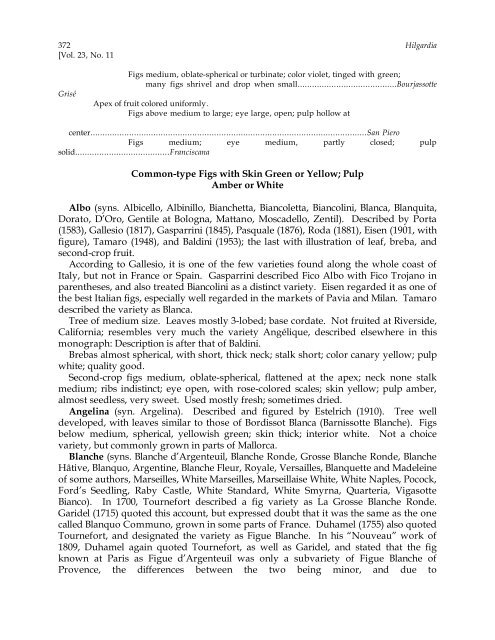Fig Varieties: A Monograph - uri=ucce.ucdavis
Fig Varieties: A Monograph - uri=ucce.ucdavis
Fig Varieties: A Monograph - uri=ucce.ucdavis
You also want an ePaper? Increase the reach of your titles
YUMPU automatically turns print PDFs into web optimized ePapers that Google loves.
372 Hilgardia<br />
[Vol. 23, No. 11<br />
Grisé<br />
<strong>Fig</strong>s medium, oblate-spherical or turbinate; color violet, tinged with green;<br />
many figs shrivel and drop when small.........................................Bourjassotte<br />
Apex of fruit colored uniformly.<br />
<strong>Fig</strong>s above medium to large; eye large, open; pulp hollow at<br />
center..................................................................................................................San Piero<br />
<strong>Fig</strong>s medium; eye medium, partly closed; pulp<br />
solid.......................................Franciscana<br />
Common-type <strong>Fig</strong>s with Skin Green or Yellow; Pulp<br />
Amber or White<br />
Albo (syns. Albicello, Albinillo, Bianchetta, Biancoletta, Biancolini, Blanca, Blanquita,<br />
Dorato, D’Oro, Gentile at Bologna, Mattano, Moscadello, Zentil). Described by Porta<br />
(1583), Gallesio (1817), Gasparrini (1845), Pasquale (1876), Roda (1881), Eisen (1901, with<br />
figure), Tamaro (1948), and Baldini (1953); the last with illustration of leaf, breba, and<br />
second-crop fruit.<br />
According to Gallesio, it is one of the few varieties found along the whole coast of<br />
Italy, but not in France or Spain. Gasparrini described Fico Albo with Fico Trojano in<br />
parentheses, and also treated Biancolini as a distinct variety. Eisen regarded it as one of<br />
the best Italian figs, especially well regarded in the markets of Pavia and Milan. Tamaro<br />
described the variety as Blanca.<br />
Tree of medium size. Leaves mostly 3-lobed; base cordate. Not fruited at Riverside,<br />
California; resembles very much the variety Angélique, described elsewhere in this<br />
monograph: Description is after that of Baldini.<br />
Brebas almost spherical, with short, thick neck; stalk short; color canary yellow; pulp<br />
white; quality good.<br />
Second-crop figs medium, oblate-spherical, flattened at the apex; neck none stalk<br />
medium; ribs indistinct; eye open, with rose-colored scales; skin yellow; pulp amber,<br />
almost seedless, very sweet. Used mostly fresh; sometimes dried.<br />
Angelina (syn. Argelina). Described and figured by Estelrich (1910). Tree well<br />
developed, with leaves similar to those of Bordissot Blanca (Barnissotte Blanche). <strong>Fig</strong>s<br />
below medium, spherical, yellowish green; skin thick; interior white. Not a choice<br />
variety, but commonly grown in parts of Mallorca.<br />
Blanche (syns. Blanche d’Argenteuil, Blanche Ronde, Grosse Blanche Ronde, Blanche<br />
Hâtive, Blanquo, Argentine, Blanche Fleur, Royale, Versailles, Blanquette and Madeleine<br />
of some authors, Marseilles, White Marseilles, Marseillaise White, White Naples, Pocock,<br />
Ford’s Seedling, Raby Castle, White Standard, White Smyrna, Quarteria, Vigasotte<br />
Bianco). In 1700, Tournefort described a fig variety as La Grosse Blanche Ronde.<br />
Garidel (1715) quoted this account, but expressed doubt that it was the same as the one<br />
called Blanquo Communo, grown in some parts of France. Duhamel (1755) also quoted<br />
Tournefort, and designated the variety as <strong>Fig</strong>ue Blanche. In his “Nouveau” work of<br />
1809, Duhamel again quoted Tournefort, as well as Garidel, and stated that the fig<br />
known at Paris as <strong>Fig</strong>ue d’Argenteuil was only a subvariety of <strong>Fig</strong>ue Blanche of<br />
Provence, the differences between the two being minor, and due to
















![Fig Trees in North Carolina [Archive] - IDigMyGarden ... - Figs 4 Fun](https://img.yumpu.com/26905320/1/190x245/fig-trees-in-north-carolina-archive-idigmygarden-figs-4-fun.jpg?quality=85)